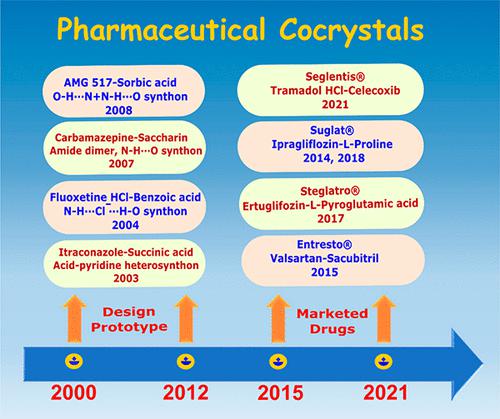当前位置:
X-MOL 学术
›
Chem. Rev.
›
论文详情
Our official English website, www.x-mol.net, welcomes your
feedback! (Note: you will need to create a separate account there.)
Crystal Engineering of Pharmaceutical Cocrystals in the Discovery and Development of Improved Drugs
Chemical Reviews ( IF 51.4 ) Pub Date : 2022-06-01 , DOI: 10.1021/acs.chemrev.1c00987 Geetha Bolla 1 , Bipul Sarma 2 , Ashwini K Nangia 3
Chemical Reviews ( IF 51.4 ) Pub Date : 2022-06-01 , DOI: 10.1021/acs.chemrev.1c00987 Geetha Bolla 1 , Bipul Sarma 2 , Ashwini K Nangia 3
Affiliation

|
The subject of crystal engineering started in the 1970s with the study of topochemical reactions in the solid state. A broad chemical definition of crystal engineering was published in 1989, and the supramolecular synthon concept was proposed in 1995 followed by heterosynthons and their potential applications for the design of pharmaceutical cocrystals in 2004. This review traces the development of supramolecular synthons as robust and recurring hydrogen bond patterns for the design and construction of supramolecular architectures, notably, pharmaceutical cocrystals beginning in the early 2000s to the present time. The ability of a cocrystal between an active pharmaceutical ingredient (API) and a pharmaceutically acceptable coformer to systematically tune the physicochemical properties of a drug (i.e., solubility, permeability, hydration, color, compaction, tableting, bioavailability) without changing its molecular structure is the hallmark of the pharmaceutical cocrystals platform, as a bridge between drug discovery and pharmaceutical development. With the design of cocrystals via heterosynthons and prototype case studies to improve drug solubility in place (2000–2015), the period between 2015 to the present time has witnessed the launch of several salt–cocrystal drugs with improved efficacy and high bioavailability. This review on the design, synthesis, and applications of pharmaceutical cocrystals to afford improved drug products and drug substances will interest researchers in crystal engineering, supramolecular chemistry, medicinal chemistry, process development, and pharmaceutical and materials sciences. The scale-up of drug cocrystals and salts using continuous manufacturing technologies provides high-value pharmaceuticals with economic and environmental benefits.
中文翻译:

药物共晶体在改进药物的发现和开发中的晶体工程
晶体工程的主题始于 1970 年代,研究固态的拓扑化学反应。1989 年发表了晶体工程的广义化学定义,1995 年提出了超分子合成子的概念,随后于 2004 年提出了异质合成子及其在药物共晶体设计中的潜在应用。这篇综述追溯了超分子合成子作为稳健且重复出现的氢的发展用于设计和构建超分子结构的键合模式,尤其是从 2000 年代初到现在的药物共晶体。活性药物成分 (API) 和药学上可接受的共成型体之间的共晶体系统地调整药物的物理化学性质(即溶解度、渗透性、水合作用、颜色、压实、压片、生物利用度)而不改变其分子结构是药物共晶体平台的标志,作为药物发现和药物开发之间的桥梁。随着通过异源合成子设计共晶和原型案例研究以提高药物溶解度(2000-2015 年),2015 年至今的这段时间见证了几种盐共晶药物的推出,这些药物具有更高的疗效和高生物利用度。这篇关于药物共晶体的设计、合成和应用以提供改进的药物产品和药物的综述将引起晶体工程、超分子化学、药物化学、工艺开发以及药物和材料科学的研究人员的兴趣。
更新日期:2022-06-01
中文翻译:

药物共晶体在改进药物的发现和开发中的晶体工程
晶体工程的主题始于 1970 年代,研究固态的拓扑化学反应。1989 年发表了晶体工程的广义化学定义,1995 年提出了超分子合成子的概念,随后于 2004 年提出了异质合成子及其在药物共晶体设计中的潜在应用。这篇综述追溯了超分子合成子作为稳健且重复出现的氢的发展用于设计和构建超分子结构的键合模式,尤其是从 2000 年代初到现在的药物共晶体。活性药物成分 (API) 和药学上可接受的共成型体之间的共晶体系统地调整药物的物理化学性质(即溶解度、渗透性、水合作用、颜色、压实、压片、生物利用度)而不改变其分子结构是药物共晶体平台的标志,作为药物发现和药物开发之间的桥梁。随着通过异源合成子设计共晶和原型案例研究以提高药物溶解度(2000-2015 年),2015 年至今的这段时间见证了几种盐共晶药物的推出,这些药物具有更高的疗效和高生物利用度。这篇关于药物共晶体的设计、合成和应用以提供改进的药物产品和药物的综述将引起晶体工程、超分子化学、药物化学、工艺开发以及药物和材料科学的研究人员的兴趣。











































 京公网安备 11010802027423号
京公网安备 11010802027423号